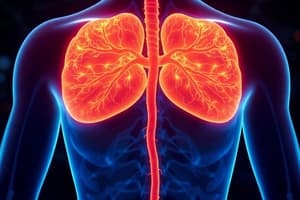Podcast
Questions and Answers
Which of the following is a characteristic of the autonomic nervous system (ANS)?
Which of the following is a characteristic of the autonomic nervous system (ANS)?
- It primarily uses sensory neurons to relay information.
- It sends impulses to cardiac muscle, smooth muscle, and glands. (correct)
- It directly controls skeletal muscle movement.
- It is under voluntary control.
The 'fight or flight' response is primarily associated with which division of the autonomic nervous system?
The 'fight or flight' response is primarily associated with which division of the autonomic nervous system?
- Somatic nervous system
- Sympathetic division (correct)
- Parasympathetic division
- Sensory division
Which of the following best describes the function of the parasympathetic division of the autonomic nervous system?
Which of the following best describes the function of the parasympathetic division of the autonomic nervous system?
- Increasing heart rate during emergencies
- Dilating pupils to improve vision
- Conserving energy and promoting 'rest and digest' functions (correct)
- Mobilizing energy stores during exercise
Which of the following is true regarding the efferent pathway of the somatic nervous system compared to the autonomic nervous system?
Which of the following is true regarding the efferent pathway of the somatic nervous system compared to the autonomic nervous system?
Which neurotransmitter is exclusively used in the somatic nervous system?
Which neurotransmitter is exclusively used in the somatic nervous system?
Where do the preganglionic neurons of the parasympathetic division originate?
Where do the preganglionic neurons of the parasympathetic division originate?
In the sympathetic division, where are the preganglionic neurons located?
In the sympathetic division, where are the preganglionic neurons located?
Which anatomical feature distinguishes the parasympathetic division from the sympathetic division?
Which anatomical feature distinguishes the parasympathetic division from the sympathetic division?
The sympathetic trunk is primarily involved in which function?
The sympathetic trunk is primarily involved in which function?
Which of the following describes the effect of the parasympathetic division on heart rate?
Which of the following describes the effect of the parasympathetic division on heart rate?
What effect does the sympathetic division have on the pupils?
What effect does the sympathetic division have on the pupils?
Which neurotransmitter is released by postganglionic fibers of the sympathetic division?
Which neurotransmitter is released by postganglionic fibers of the sympathetic division?
What type of receptor binds acetylcholine released by postganglionic fibers in the parasympathetic division?
What type of receptor binds acetylcholine released by postganglionic fibers in the parasympathetic division?
Which of the following is primarily innervated by the sympathetic nervous system?
Which of the following is primarily innervated by the sympathetic nervous system?
If a person is experiencing increased heart rate and bronchodilation, which division of the autonomic nervous system is likely activated?
If a person is experiencing increased heart rate and bronchodilation, which division of the autonomic nervous system is likely activated?
In the autonomic nervous system, which type of receptors are found on all postganglionic neurons?
In the autonomic nervous system, which type of receptors are found on all postganglionic neurons?
What is the primary function of adrenergic receptors?
What is the primary function of adrenergic receptors?
Which of the following actions is associated with the α (alpha) adrenergic receptors?
Which of the following actions is associated with the α (alpha) adrenergic receptors?
What is the effect of activating beta (β) adrenergic receptors in the heart?
What is the effect of activating beta (β) adrenergic receptors in the heart?
Which of the following best describes why the sympathetic division can have body-wide effects?
Which of the following best describes why the sympathetic division can have body-wide effects?
Flashcards
Autonomic Nervous System (ANS)
Autonomic Nervous System (ANS)
Part of the peripheral nervous system that controls involuntary functions, sending motor impulses to organs and glands.
Sympathetic Division
Sympathetic Division
The division of the ANS responsible for the "fight or flight" response and mobilizing body systems during activity.
Parasympathetic Division
Parasympathetic Division
The division of the ANS that conserves energy and promotes housekeeping functions during rest; "rest and digest".
Efferent Pathway
Efferent Pathway
Signup and view all the flashcards
Autonomic Neurotransmitters
Autonomic Neurotransmitters
Signup and view all the flashcards
Sympathetic Trunk
Sympathetic Trunk
Signup and view all the flashcards
Parasympathetic Division
Parasympathetic Division
Signup and view all the flashcards
Sympathetic Division
Sympathetic Division
Signup and view all the flashcards
Effects of Sympathetic Division
Effects of Sympathetic Division
Signup and view all the flashcards
Parasympathetic Effects
Parasympathetic Effects
Signup and view all the flashcards
Parasympathetic Anatomy
Parasympathetic Anatomy
Signup and view all the flashcards
Sympathetic Anatomy
Sympathetic Anatomy
Signup and view all the flashcards
Acetylcholine (ACh)
Acetylcholine (ACh)
Signup and view all the flashcards
Cholinergic Receptors
Cholinergic Receptors
Signup and view all the flashcards
Norepinephrine
Norepinephrine
Signup and view all the flashcards
Adrenergic Receptors
Adrenergic Receptors
Signup and view all the flashcards
Somatic Efferent Pathway
Somatic Efferent Pathway
Signup and view all the flashcards
Origin of Parasympathetic Neurons
Origin of Parasympathetic Neurons
Signup and view all the flashcards
Origin of Sympathetic Neurons
Origin of Sympathetic Neurons
Signup and view all the flashcards
Sensory Input, Somatic Nervous System
Sensory Input, Somatic Nervous System
Signup and view all the flashcards
Study Notes
- The autonomic nervous system (ANS) sends motor impulses to organs and glands.
Divisions of the ANS
- Sympathetic division initiates the "fight or flight" response
- Parasympathetic division controls the "rest and digest" response
Effectors
- Somatic nervous system targets skeletal muscle
- Autonomic nervous system targets smooth and cardiac muscle, and glands
Efferent Pathway
- Somatic nervous system uses one motor neuron to reach the effector
- Autonomic nervous system uses two motor neurons synapsing at an autonomic ganglion
Neurotransmitters
- Somatic nervous system exclusively uses acetylcholine (ACh)
- Autonomic nervous system preganglionic fibers secrete ACh, postganglionic fibers secrete ACh (parasympathetic) or norepinephrine (NE) (sympathetic)
Parasympathetic Division
- Promotes "rest and digest" functions
- Nerves originate from the brain and sacral region of the spinal cord
- Preganglionic fibers are longer than postganglionic fibers
Sympathetic Division
- Promotes the "fight or flight" response
- Nerves originate from the thoracic and lumbar regions of the spinal cord
- Postganglionic fibers are longer than preganglionic fibers
The Parasympathetic Division Anatomy
- Long preganglionic fibers originate from the brain and sacral spinal cord
- Synapses occur at autonomic ganglia located in or near the effector organs
- Very short postganglionic fibers then innervate the target organ/gland
The Parasympathetic Division Effects
- Decreases heart rate
- Constricts pupils
- Increases actvitiy of digestive organs and glands
- Constricts air passages in the lungs
Sympathetic Division Anatomy
- Short preganglionic fibers originate from the thoracic and lumbar spinal cord
- Synapses occur at autonomic ganglia located in the sympathetic trunk
- Long postganglionic fibers then innervate the target organ/gland
Sympathetic Division Effects
- Increases heart rate and blood pressure
- Dilates pupils
- Decreases activity of digestive organs and glands
- Dilates air passages in the lungs
Sympathetic Trunk
- Consists of paired chains of ganglia located laterally on either side of the spinal cord
- Location of sympathetic division synapsing
- Nerve impulses may ascend or descend within the trunk before synapsing
Neurotransmitters and Receptors: Acetylcholine
- Secreted by cholinergic fibers (all somatic fibers, all preganglionic ANS fibers, all postganglionic parasympathetic fibers).
- Cholinergic receptors are in autonomic ganglia and on organs with parasympathetic innervation; these are nicoticic and muscarinic
Nicotinic
- Found at the neuromuscular junction (NMJ) and autonomic ganglia
Muscarinic
- Found at organs under parasympathetic innervation
Neurotransmitters and Receptors: Norepinephrine
- Secreted by adrenergic fibers (all postganglionic sympathetic fibers).
- Adrenergic receptors are on organs with sympathetic innervation, with two types
Alpha
- Found in blood vessels serving viscera; cause constriction
Beta
- Found in the heart (increasing rate) and blood vessels serving lungs and skeletal muscles (causing dilation)
Studying That Suits You
Use AI to generate personalized quizzes and flashcards to suit your learning preferences.




